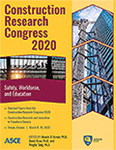Construction Research Congress 2020
Students’ Time Perceptions on Mastering Construction Content in Different Educational Models
Publication: Construction Research Congress 2020: Safety, Workforce, and Education
ABSTRACT
Exploring construction education models, defined by the amount of lab or lecture content, and their characteristics, has been a focal point of many studies in recent years. Researchers investigate different aspects of construction curricula and provide guidelines to improve construction education. The range of factors and variables involved makes it hard to draw a solid conclusion and introduce a best-practice teaching methodology. Construction programs offer a curriculum which covers major subjects of the construction field, yet, the depth and breadth of each subject covered vary among construction programs and, hence, setting a benchmark for construction educators is not a simple process. However, addressing different aspects of construction education models provides educators and administrators with pieces to be utilized in a curriculum development process. One of these factors is students’ perception toward educational variables in the time context. Students’ perceptions strongly impact the outcome of a curriculum development program. This paper reports on a study conducted in the construction programs at Mississippi State University and Central Connecticut State University. The educational model of the construction program is different at these two institutions which creates different perceptions in students and faculty toward the construction educational content, and especially the associated time variable. This paper illustrates the similarities and differences of timing perception between two educational models and correlates the model with a variation of students’ perceptions. The results indicate the importance of time perception in educational models to achieve content excellence.
Get full access to this article
View all available purchase options and get full access to this chapter.
REFERENCES
Baker, D. P., Fabrega, R., Galindo, C., and Mishook, J. (2004). “Instructional time and national achievement: Cross-national evidence.” Prospects, 34(3), 311-334.
Clark, D., Gill, D., Prowse, V., and Rush, M. (2017). Using goals to motivate college Students: theory and evidence from field experiments, Cambridge, MA: National Bureau of Economic Research.
Delgado, C., and Wolf, L. (2017). “Time on task: perceived and measured time in online courses for students and faculty”, Journal of Nursing Education and Practice, 7(5), 27-32.
Gökçe, F. (2012). “Opinions of teachers and parents about time spent by students at school, lesson hours, break times, holidays and school terms.” Educational Sciences: Theory and Practice, 12(4), 2555-2560.
Hyat, R. Y. (2011, 6 29). The influence of time spent by students engaged in co-curricular involvement, online social networking and studying and doing coursework on their academic achievement. Graduate Theses and Dissertations. University of South Florida.
Matthews, W. J., and Meck, W. H. (2014). “Time perception: the bad news and the good.” Wiley Interdisciplinary Reviews. Cognitive Science, 5(4), 429–446.
McCormick, A. C. (2011). “It's about time: what to make of reported declines in how much college students study.” Liberal Education, 97(1). Retrieved from https://www.aacu.org/publications-research/periodicals/its-about-time-what-make-reported-declines-how-much-college
Mercatante, A. E. (2009). Students’ perceptions of time and its influence on recreational. Indiana University.
Nonis, S. A., and Hudson, G. I. (2005). Academic Performance of College Students: Influence of Time Spent Studying and Working. The Journal of Education for Business, 81(3), 151-159.
Phillips, J. A., Schumacher, C., and Arif, S. (2016). “Time spent, workload, and student and faculty perceptions in a blended learning environment.” American Journal of Pharmaceutical Education, 80(6).
Schaffhauser, D. (2016, 9 7). Study: time spent with course content isn't biggest lms predictor of student success. Retrieved from TheJournal: https://thejournal.com/articles/2016/09/07/time-spent-with-course-content-isnt-biggest-lms-predictor-of-student-success.aspx
Stan, E. (2012). “The role of grades in motivating students to learn.” International Conference on Education and Educational Psychology (ICEEPSY 2012) (pp. 1998-2003). Procedia - Social and Behavioral Sciences.
Thorpe, M. (2006). Perceptions about time and learning.Cairn. info pour Lavoisier.
Time Perception. (2019, 7 1). Retrieved from Exactly What Is Time?: https://www.exactlywhatistime.com/psychology-of-time/time-perception/
Information & Authors
Information
Published In
Construction Research Congress 2020: Safety, Workforce, and Education
Pages: 708 - 716
Editors: Mounir El Asmar, Ph.D., Arizona State University, David Grau, Ph.D., Arizona State University, and Pingbo Tang, Ph.D., Arizona State University
ISBN (Online): 978-0-7844-8287-2
Copyright
© 2020 American Society of Civil Engineers.
History
Published online: Nov 9, 2020
Published in print: Nov 9, 2020
Authors
Metrics & Citations
Metrics
Citations
Download citation
If you have the appropriate software installed, you can download article citation data to the citation manager of your choice. Simply select your manager software from the list below and click Download.
